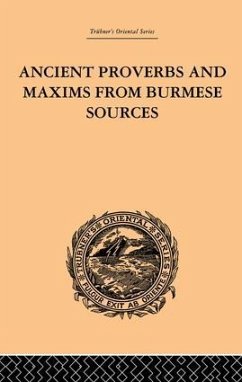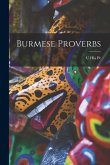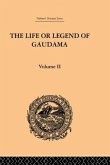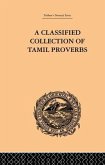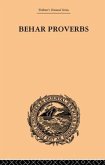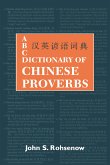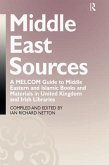- Broschiertes Buch
- Merkliste
- Auf die Merkliste
- Bewerten Bewerten
- Teilen
- Produkt teilen
- Produkterinnerung
- Produkterinnerung
First published in 2000. This is Volume II of seven of a series on Southeast Asia. Written in 1886, this is a collection of ancient proverbs and maxims from Burmese sources or the Niti literature of Burma. The Sanskrit-Pali word Niti is equivalent to conduct in its abstract, and guide in its concrete signification.
Andere Kunden interessierten sich auch für
![Burmese Proverbs Burmese Proverbs]() Burmese Proverbs20,99 €
Burmese Proverbs20,99 €![The Life or Legend of Gaudama the Buddha of the Burmese The Life or Legend of Gaudama the Buddha of the Burmese]() P. BigandetThe Life or Legend of Gaudama the Buddha of the Burmese68,99 €
P. BigandetThe Life or Legend of Gaudama the Buddha of the Burmese68,99 €![A Classical Collection of Tamil Proverbs A Classical Collection of Tamil Proverbs]() Herman JensenA Classical Collection of Tamil Proverbs69,99 €
Herman JensenA Classical Collection of Tamil Proverbs69,99 €![Behar Proverbs Behar Proverbs]() John ChristianBehar Proverbs46,99 €
John ChristianBehar Proverbs46,99 €![ABC Dictionary of Chinese Proverbs (Yanyu) ABC Dictionary of Chinese Proverbs (Yanyu)]() ABC Dictionary of Chinese Proverbs (Yanyu)74,99 €
ABC Dictionary of Chinese Proverbs (Yanyu)74,99 €![Middle East Sources Middle East Sources]() Ian Richard NettonMiddle East Sources46,99 €
Ian Richard NettonMiddle East Sources46,99 €![A Researcher's Guide to Sources on Soviet Social History in the 1930s A Researcher's Guide to Sources on Soviet Social History in the 1930s]() Sheila FitzpatrickA Researcher's Guide to Sources on Soviet Social History in the 1930s45,99 €
Sheila FitzpatrickA Researcher's Guide to Sources on Soviet Social History in the 1930s45,99 €-
-
-
First published in 2000. This is Volume II of seven of a series on Southeast Asia. Written in 1886, this is a collection of ancient proverbs and maxims from Burmese sources or the Niti literature of Burma. The Sanskrit-Pali word Niti is equivalent to conduct in its abstract, and guide in its concrete signification.
Hinweis: Dieser Artikel kann nur an eine deutsche Lieferadresse ausgeliefert werden.
Hinweis: Dieser Artikel kann nur an eine deutsche Lieferadresse ausgeliefert werden.
Produktdetails
- Produktdetails
- Verlag: Routledge
- Seitenzahl: 194
- Erscheinungstermin: 23. Dezember 2014
- Englisch
- Abmessung: 216mm x 140mm x 11mm
- Gewicht: 252g
- ISBN-13: 9781138862210
- ISBN-10: 1138862215
- Artikelnr.: 42485985
- Herstellerkennzeichnung
- Libri GmbH
- Europaallee 1
- 36244 Bad Hersfeld
- gpsr@libri.de
- Verlag: Routledge
- Seitenzahl: 194
- Erscheinungstermin: 23. Dezember 2014
- Englisch
- Abmessung: 216mm x 140mm x 11mm
- Gewicht: 252g
- ISBN-13: 9781138862210
- ISBN-10: 1138862215
- Artikelnr.: 42485985
- Herstellerkennzeichnung
- Libri GmbH
- Europaallee 1
- 36244 Bad Hersfeld
- gpsr@libri.de
James Gray
Chapter 1 The Lokanîti. 1 I have selected this Nîti for translation before the others because it is the most popular in Burma. Its popularity during recent years has been increased by printed editions of it emanating from the presses of Rangoon. It forms
besides
a textbook for the vernacular schools of the province. The Pâli text of it is very corrupt in many places
and an emended edition has not yet been attempted. The Lokanîti ("Worldly Behaviour") is divided into seven sections
viz.
(1) T HE E VIL -D OER
(2) T HE G OOD M AN
(3) T HE E VIL -D OER
(4) F RIENDSHIP
(5) W OMAN
(6) K INGS
and (7) M ISCELLANEOUS. It was
for the first time
rendered into Burmese in A.D. 1835
during the reign of Bhagidaw
by the guru Cakkandâbhisîri; Chapter 2 The Dhammanîti. 1 The Dhammanîti consists of 414 stanzas in 24 sections. It was for the first time translated into Burmese by the head priest Tipitakali?kâra Mahâdhamma in 1784 A.D.
in obedience to the order of King Bodopra. The following three stanzas are introductory:- "Vanditvâ ratana? se??ha? Nissâya pubbake garu? Nîtidhamma? pavakkhâmi Sabbalokasukhâvaha?. Âcariyo ca sippañca Paññâ sutar? kathâ dhana? Deso ca nissayo mitta? Dujjano sujano bala?. Itthî putto ca dâso ca Gharâvâso katâkato Ñâtabbo ca ala?kâro Râjadhammopasevako Dukâdimissako ceva Paki??ako ti mâtikâ." Translation:- Having paid homage to the Three Gems and to my venerable preceptor
I shall recite the Dhantmanîti
based on ancient works
for the benefit of the whole world. The Preceptor
Scholarship
Wisdom
Knowledge
Conversation
Wealth
Habitation
Dependence
Friendship
the Bad Man
the Good Man
the Powerful; Women
Children
Servants
Residence
What should be done
What should not be done
What should be known
Ornamentation
Royalty
Ministration
Things taken by twos and threes
and Miscellaneous : these form the subjects of discourse; Chapter 3 Râjanîti. 1 This anthology
based on the Indian Dharma?âstras
was compiled by the Brahmans Anantañâ?a and Ga?âmissaka. It must not be confounded with the Râjanîti of Lallu Lâla in the Braj dialect
which is comparatively modern ( A.D. 1859)
and based chiefly on the Sanskrit Hitopade?a. Chronologically
the Burmese compilation stands after the Lokanîti and Dhammanîti
and has for its prototype the Râjanîti?âstra of C?ânakya
the famous minister of C?andragupta
king of Pâ?aliputra; Chapter 4 The Suttava??hananîti. 1 This anthology was compiled and translated into Burmese by Saddhammanandîmahâthera of Chaunkauk in Upper Burma. Suttava??hanaîti signifies the "Guide for the Advancement of Knowledge." It is a collection of maxims from Buddhistic sources chiefly;
besides
a textbook for the vernacular schools of the province. The Pâli text of it is very corrupt in many places
and an emended edition has not yet been attempted. The Lokanîti ("Worldly Behaviour") is divided into seven sections
viz.
(1) T HE E VIL -D OER
(2) T HE G OOD M AN
(3) T HE E VIL -D OER
(4) F RIENDSHIP
(5) W OMAN
(6) K INGS
and (7) M ISCELLANEOUS. It was
for the first time
rendered into Burmese in A.D. 1835
during the reign of Bhagidaw
by the guru Cakkandâbhisîri; Chapter 2 The Dhammanîti. 1 The Dhammanîti consists of 414 stanzas in 24 sections. It was for the first time translated into Burmese by the head priest Tipitakali?kâra Mahâdhamma in 1784 A.D.
in obedience to the order of King Bodopra. The following three stanzas are introductory:- "Vanditvâ ratana? se??ha? Nissâya pubbake garu? Nîtidhamma? pavakkhâmi Sabbalokasukhâvaha?. Âcariyo ca sippañca Paññâ sutar? kathâ dhana? Deso ca nissayo mitta? Dujjano sujano bala?. Itthî putto ca dâso ca Gharâvâso katâkato Ñâtabbo ca ala?kâro Râjadhammopasevako Dukâdimissako ceva Paki??ako ti mâtikâ." Translation:- Having paid homage to the Three Gems and to my venerable preceptor
I shall recite the Dhantmanîti
based on ancient works
for the benefit of the whole world. The Preceptor
Scholarship
Wisdom
Knowledge
Conversation
Wealth
Habitation
Dependence
Friendship
the Bad Man
the Good Man
the Powerful; Women
Children
Servants
Residence
What should be done
What should not be done
What should be known
Ornamentation
Royalty
Ministration
Things taken by twos and threes
and Miscellaneous : these form the subjects of discourse; Chapter 3 Râjanîti. 1 This anthology
based on the Indian Dharma?âstras
was compiled by the Brahmans Anantañâ?a and Ga?âmissaka. It must not be confounded with the Râjanîti of Lallu Lâla in the Braj dialect
which is comparatively modern ( A.D. 1859)
and based chiefly on the Sanskrit Hitopade?a. Chronologically
the Burmese compilation stands after the Lokanîti and Dhammanîti
and has for its prototype the Râjanîti?âstra of C?ânakya
the famous minister of C?andragupta
king of Pâ?aliputra; Chapter 4 The Suttava??hananîti. 1 This anthology was compiled and translated into Burmese by Saddhammanandîmahâthera of Chaunkauk in Upper Burma. Suttava??hanaîti signifies the "Guide for the Advancement of Knowledge." It is a collection of maxims from Buddhistic sources chiefly;
Chapter 1 The Lokanîti. 1 I have selected this Nîti for translation before the others because it is the most popular in Burma. Its popularity during recent years has been increased by printed editions of it emanating from the presses of Rangoon. It forms
besides
a textbook for the vernacular schools of the province. The Pâli text of it is very corrupt in many places
and an emended edition has not yet been attempted. The Lokanîti ("Worldly Behaviour") is divided into seven sections
viz.
(1) T HE E VIL -D OER
(2) T HE G OOD M AN
(3) T HE E VIL -D OER
(4) F RIENDSHIP
(5) W OMAN
(6) K INGS
and (7) M ISCELLANEOUS. It was
for the first time
rendered into Burmese in A.D. 1835
during the reign of Bhagidaw
by the guru Cakkandâbhisîri; Chapter 2 The Dhammanîti. 1 The Dhammanîti consists of 414 stanzas in 24 sections. It was for the first time translated into Burmese by the head priest Tipitakali?kâra Mahâdhamma in 1784 A.D.
in obedience to the order of King Bodopra. The following three stanzas are introductory:- "Vanditvâ ratana? se??ha? Nissâya pubbake garu? Nîtidhamma? pavakkhâmi Sabbalokasukhâvaha?. Âcariyo ca sippañca Paññâ sutar? kathâ dhana? Deso ca nissayo mitta? Dujjano sujano bala?. Itthî putto ca dâso ca Gharâvâso katâkato Ñâtabbo ca ala?kâro Râjadhammopasevako Dukâdimissako ceva Paki??ako ti mâtikâ." Translation:- Having paid homage to the Three Gems and to my venerable preceptor
I shall recite the Dhantmanîti
based on ancient works
for the benefit of the whole world. The Preceptor
Scholarship
Wisdom
Knowledge
Conversation
Wealth
Habitation
Dependence
Friendship
the Bad Man
the Good Man
the Powerful; Women
Children
Servants
Residence
What should be done
What should not be done
What should be known
Ornamentation
Royalty
Ministration
Things taken by twos and threes
and Miscellaneous : these form the subjects of discourse; Chapter 3 Râjanîti. 1 This anthology
based on the Indian Dharma?âstras
was compiled by the Brahmans Anantañâ?a and Ga?âmissaka. It must not be confounded with the Râjanîti of Lallu Lâla in the Braj dialect
which is comparatively modern ( A.D. 1859)
and based chiefly on the Sanskrit Hitopade?a. Chronologically
the Burmese compilation stands after the Lokanîti and Dhammanîti
and has for its prototype the Râjanîti?âstra of C?ânakya
the famous minister of C?andragupta
king of Pâ?aliputra; Chapter 4 The Suttava??hananîti. 1 This anthology was compiled and translated into Burmese by Saddhammanandîmahâthera of Chaunkauk in Upper Burma. Suttava??hanaîti signifies the "Guide for the Advancement of Knowledge." It is a collection of maxims from Buddhistic sources chiefly;
besides
a textbook for the vernacular schools of the province. The Pâli text of it is very corrupt in many places
and an emended edition has not yet been attempted. The Lokanîti ("Worldly Behaviour") is divided into seven sections
viz.
(1) T HE E VIL -D OER
(2) T HE G OOD M AN
(3) T HE E VIL -D OER
(4) F RIENDSHIP
(5) W OMAN
(6) K INGS
and (7) M ISCELLANEOUS. It was
for the first time
rendered into Burmese in A.D. 1835
during the reign of Bhagidaw
by the guru Cakkandâbhisîri; Chapter 2 The Dhammanîti. 1 The Dhammanîti consists of 414 stanzas in 24 sections. It was for the first time translated into Burmese by the head priest Tipitakali?kâra Mahâdhamma in 1784 A.D.
in obedience to the order of King Bodopra. The following three stanzas are introductory:- "Vanditvâ ratana? se??ha? Nissâya pubbake garu? Nîtidhamma? pavakkhâmi Sabbalokasukhâvaha?. Âcariyo ca sippañca Paññâ sutar? kathâ dhana? Deso ca nissayo mitta? Dujjano sujano bala?. Itthî putto ca dâso ca Gharâvâso katâkato Ñâtabbo ca ala?kâro Râjadhammopasevako Dukâdimissako ceva Paki??ako ti mâtikâ." Translation:- Having paid homage to the Three Gems and to my venerable preceptor
I shall recite the Dhantmanîti
based on ancient works
for the benefit of the whole world. The Preceptor
Scholarship
Wisdom
Knowledge
Conversation
Wealth
Habitation
Dependence
Friendship
the Bad Man
the Good Man
the Powerful; Women
Children
Servants
Residence
What should be done
What should not be done
What should be known
Ornamentation
Royalty
Ministration
Things taken by twos and threes
and Miscellaneous : these form the subjects of discourse; Chapter 3 Râjanîti. 1 This anthology
based on the Indian Dharma?âstras
was compiled by the Brahmans Anantañâ?a and Ga?âmissaka. It must not be confounded with the Râjanîti of Lallu Lâla in the Braj dialect
which is comparatively modern ( A.D. 1859)
and based chiefly on the Sanskrit Hitopade?a. Chronologically
the Burmese compilation stands after the Lokanîti and Dhammanîti
and has for its prototype the Râjanîti?âstra of C?ânakya
the famous minister of C?andragupta
king of Pâ?aliputra; Chapter 4 The Suttava??hananîti. 1 This anthology was compiled and translated into Burmese by Saddhammanandîmahâthera of Chaunkauk in Upper Burma. Suttava??hanaîti signifies the "Guide for the Advancement of Knowledge." It is a collection of maxims from Buddhistic sources chiefly;

